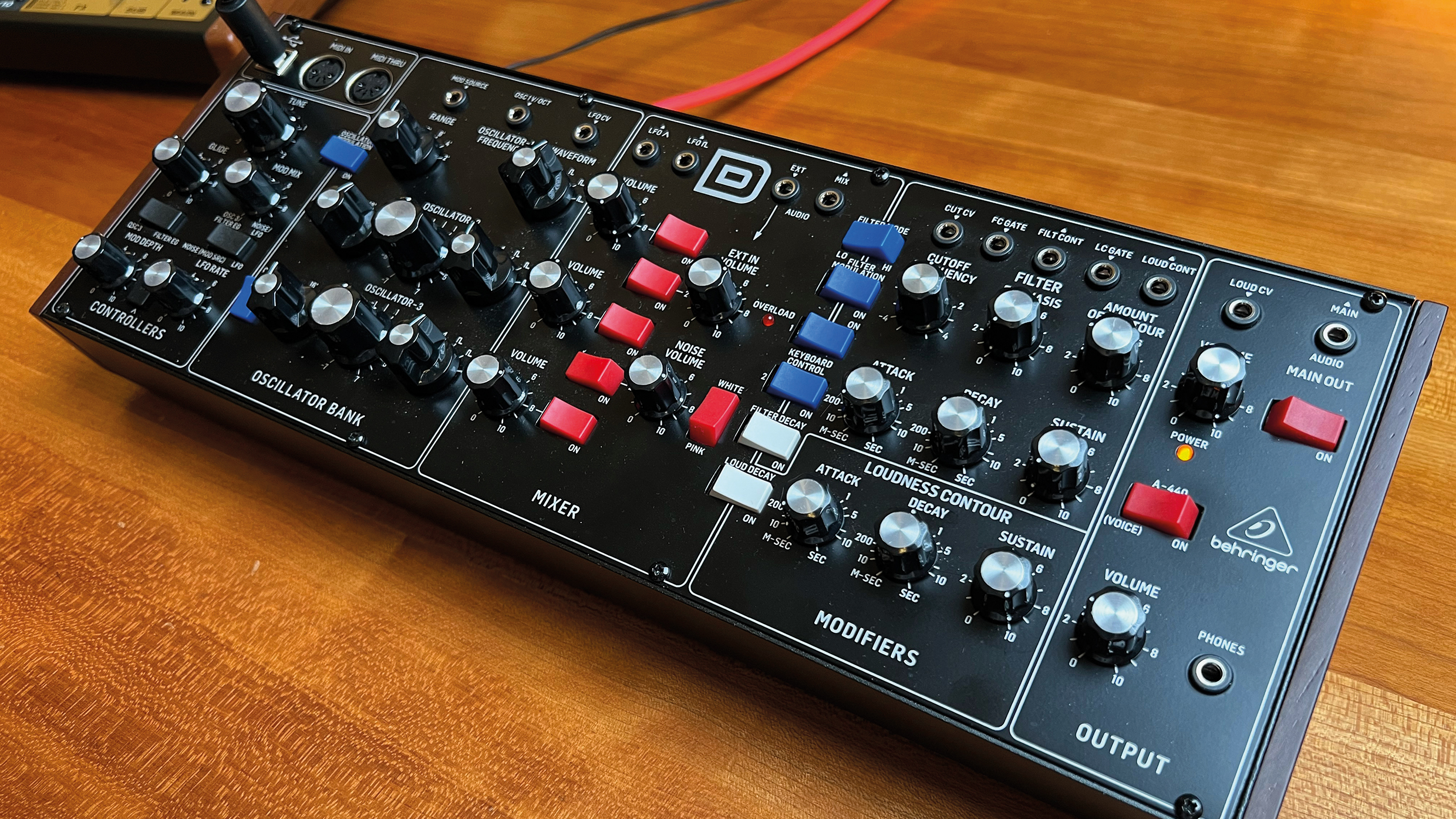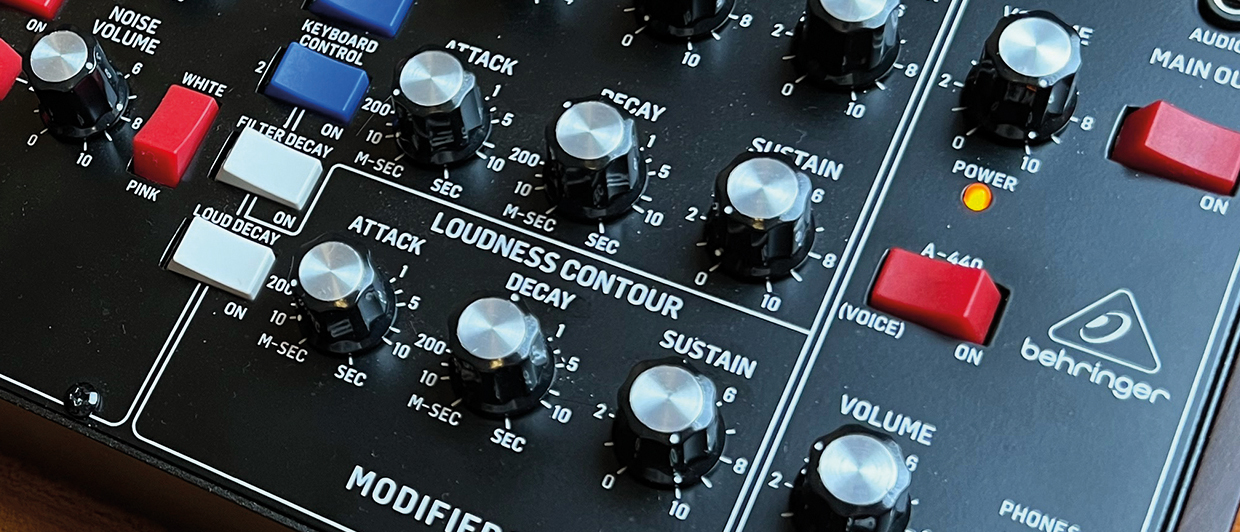MusicRadar Verdict
Even without the ability to save patches, Behringer’s first synth clone has proven to be a hit.
Pros
- +
Behringer nailed the sound of the Model D’s circuit; vintage snobs can rest assured.
- +
Eurorack interactivity greatly expands what the Model D can do when integrated into a larger system.
- +
Affordable for a range of synthesists.
Cons
- -
The all-analogue Model D has no memory at all so can’t save patches.
- -
Some early units of the Model D had tuning issues.
- -
The somewhat limited architecture of the Model D isn’t as inspiring as new, unexplored circuits.
MusicRadar's got your back
Behringer Model D: What is it?
It’s hard to find a synth design more iconic than that of Bob Moog’s Minimoog Model D, a three-oscillator instrument that can be heard on decades of recordings across many genres. Its fluid ladder filter and array of oscillator waveforms made it the go-to sound design machine in its time, so when Behringer announced it was making its own version of the Model D, albeit in tabletop form with a few tweaks, you could say that more than a few heads turned. When the price was announced at a mere $299, jaws dropped.
So just how similar is Behringer’s new Model D to its Moog forefather? Well, just taking a look at the front panel tells you most of the story. Three oscillators, each with a choice of five waveforms, feed into a mixer, which then goes into a 24dB ladder filter that can be set to either high or low pass modes. It’s worth noting that the original Model D was only low-pass, so this constitutes a nice modern enhancement. The filter has that lovely squelch you’d expect from anything with a 24dB ladder design and the resonance allows the filter to self-oscillate beautifully on the Model D.
Going back to the mixer, each oscillator has on/off switches as well as level controls, via big chunky knobs, as well as level controls for a noise source and an external input. There are two envelopes, one affecting the filter and one affecting the volume contour. Each has the ability to defeat the Decay portion. There’s a single LFO with square or triangle shapes that can be routed to either the filter or the oscillators. And that’s pretty much it!
The “what you see is what you get” philosophy makes it much easier to recall sounds
Again, this is not new territory for Model D aficionados, and that’s the point! The circuit compared to a lot of modern synths is very simple, but given that there is no way to store patches, Model D’s “what you see is what you get” philosophy makes it much easier to recall sounds you’ve come up with. You’ll just need to keep a notepad or camera at the ready!
Behringer’s Model D, as mentioned, comes in a small tabletop format that also can fit inside a Eurorack case. Giving users both options is incredibly wise, as the Model D can be used on its own, as part of your DAW setup using its USB/midi port, or as part of a larger Eurorack system. The Model D also adds 1/8” Eurorack-compatible inputs and outputs on its faceplate, giving users the ability to mix and match modulation sources from other modules, or simply send the raw oscillator shapes out to other parts of your modular synth.

Behringer Model D: Performance and verdict
So how has Behringer’s Model D held up since its arrival on the scene in 2017? Behringer has since significantly increased its synthesizer lineup, delivering reissues of the Pro-1, CAT, and WASP synths. But none of these instruments, even the Pro-1, have successfully achieved the same studied lineage and iconic sound of the Model D.
Thankfully, the chunky switches and big knobs of our Model D have held up over time, even after years of extensive daily studio use. We initially had a bit of concern over the tuning range of the oscillators, as ours was one of the first batch and needed to be sent back for calibration, but since then, it’s been nothing but solid.
Want all the hottest music and gear news, reviews, deals, features and more, direct to your inbox? Sign up here.
Using Model D for MIDI-to-CV conversion
One of the most useful reasons for having the Model D has nothing to do with its sound at all, and that’s its use as a makeshift MIDI-to-CV converter. Given that there’s a USB input that passes along note information, which is then sent out of the Gate and CV jacks, you can use the Model D as a pseudo MIDI-to-CV converter. This is handy if you have other modular gear that you want to sequence from inside your DAW, but you don’t have a DC-coupled audio interface.

Conclusion
Thankfully Behringer has continued to update the Model D with small but significant upgrades. In December of 2018, the firmware was updated to 1.1.1, which saw Behringer implementing an online tool to help make adjustments to the poly chain settings and improved re-trigger reliability when playing legato notes.
Now that the Model D has been out for a few years and it’s been put through its paces by many a producer, we can comfortably say that it really does nail that vintage sound and has found a permanent place in our workflow.
MusicRadar verdict: Even without the ability to save patches, Behringer’s first synth clone has proven to be a hit.
Behringer Model D: The web says
"Probably the most viable option for those who would love to get their hands on the MiniMoog but can't justify the expenditure."
Music Critic
Behringer Model D: Hands-on demos
loopop
Andertons Synths, Keys and Tech
Todd Smith Music
Behringer Model D: Specifications
- KEY FEATURES Analogue synth with triple VCO design.
- DIMENSIONS: 90 x 374 x 136 mm.
- WEIGHT: 1.7 kg.
- CONTACT: Behringer
